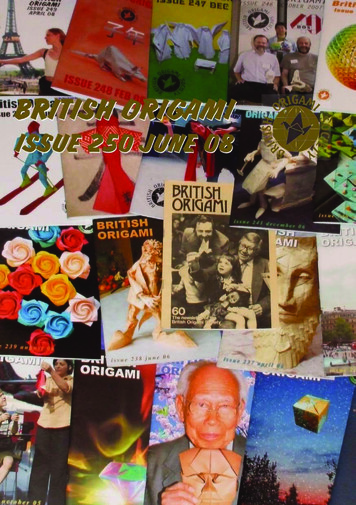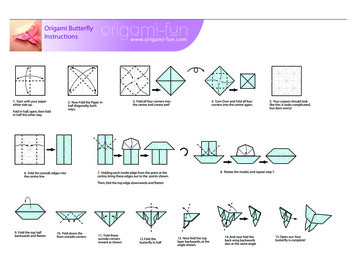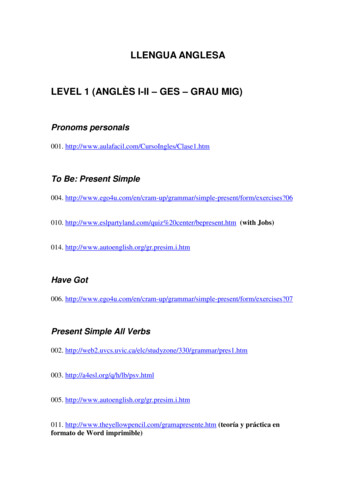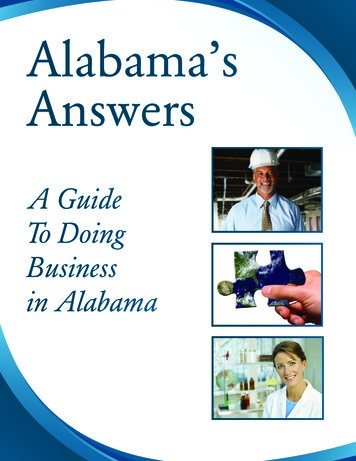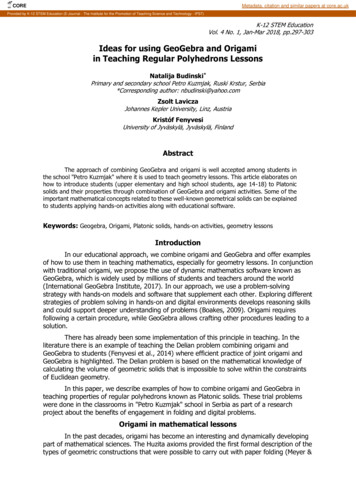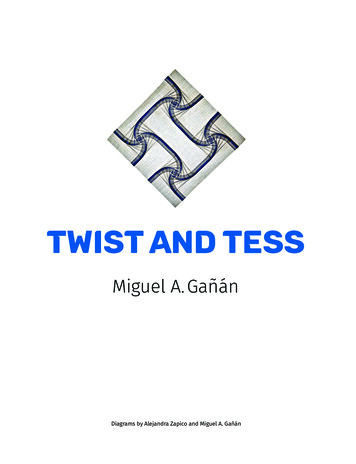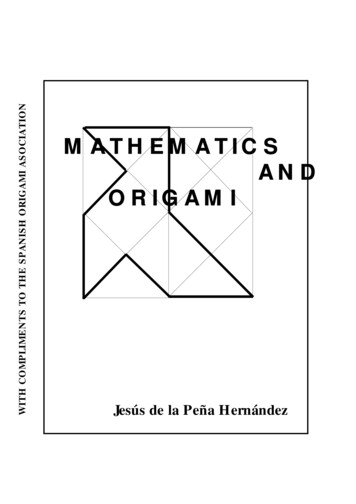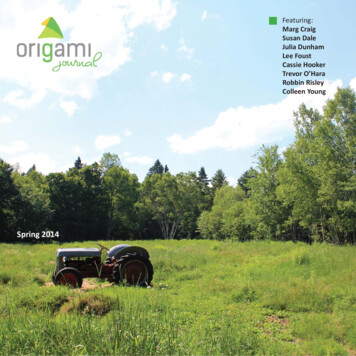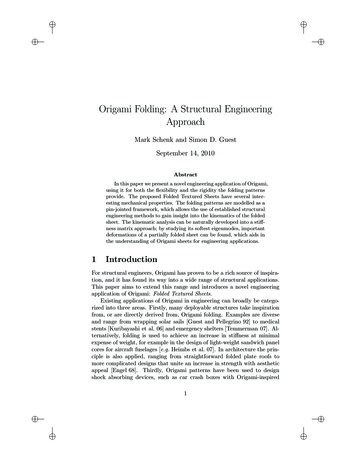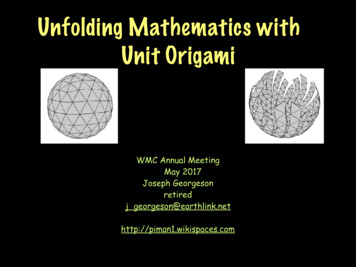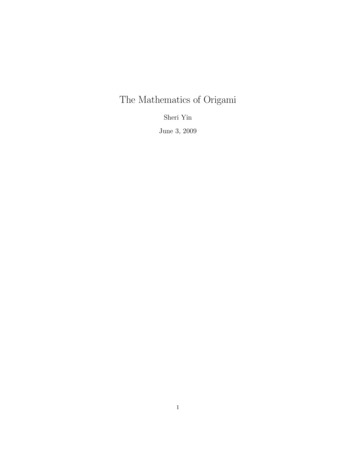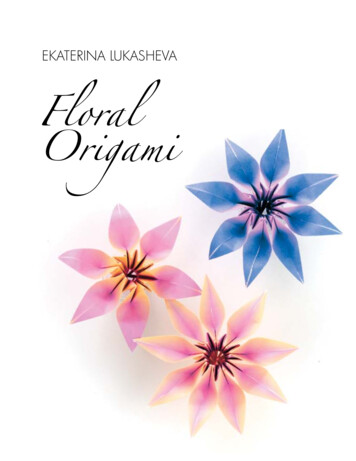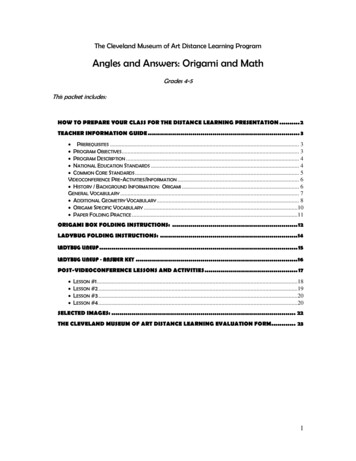
Transcription
The Cleveland Museum of Art Distance Learning ProgramAngles and Answers: Origami and MathGrades 4-5This packet includes:HOW TO PREPARE YOUR CLASS FOR THE DISTANCE LEARNING PRESENTATION . 2TEACHER INFORMATION GUIDE . 3 PREREQUISITES . 3 PROGRAM OBJECTIVES. 3 PROGRAM DESCRIPTION . 4 NATIONAL EDUCATION STANDARDS . 4 COMMON CORE STANDARDS . 5VIDEOCONFERENCE PRE-ACTIVITIES/INFORMATION . 6 HISTORY / BACKGROUND INFORMATION: ORIGAMI . 6GENERAL VOCABULARY . 7 ADDITIONAL GEOMETRY VOCABULARY . 8 ORIGAMI SPECIFIC VOCABULARY .10 PAPER FOLDING PRACTICE .11ORIGAMI BOX FOLDING INSTRUCTIONS: . 12LADYBUG FOLDING INSTRUCTIONS: .14LADYBUG LINEUP . 15LADYBUG LINEUP - ANSWER KEY .16POST-VIDEOCONFERENCE LESSONS AND ACTIVITIES . 17 LESSON #1 .18LESSON #2 .19LESSON #3 .20LESSON #4 .20SELECTED IMAGES: . 22THE CLEVELAND MUSEUM OF ART DISTANCE LEARNING EVALUATION FORM. 231
How to Prepare Your Class for the Distance LearningPresentationTeacher Information will be sent or made available to you prior to theprogram.Please familiarize yourself with the materials and discuss them with yourclass.Have the Teacher Information Packet (T.I.P.) materials on hand in theclassroom, ready for the program. These materials may be used duringthe videoconference.Be prepared to facilitate by calling on students yourself during the lesson.Students are sometimes initially shy about responding to questions duringa distance learning lesson.Explain to students that this is an interactive medium and encourage themto ask questions.Reinforce topics discussed in the program by asking students to completesome of the suggested pre- and post-conference activities in the TeacherInformation Packet.We ask teachers, after the program, to please fill out the Evaluation Formand return it to:Dale Hilton/Distance LearningThe Cleveland Museum of Art11150 East BoulevardCleveland, OH 44106Thank You!2
Angles and Answers: Origami and MathTeacher Information Guide PrerequisitesFOR THE VIDEO CONFERENCE YOU WILL NEED:1. 2 pieces of Origami paper per student – or square sheets no smallerthan 6x6 inches.2. Copies of the Ladybug Folding instructions.3. Copies of the Origami Box instructions.4. Copies of the Vocabulary are recommended for the students.5. Markers (optional). Program ObjectivesEducational/Program Objectives:1. Name and identify geometric vocabulary.2. Use technology to communicate and process information.3. Apply concepts of geometry to create art.4. Identify a variety of shapes and angles.3
Program DescriptionStudents reinforce their knowledge of the vocabulary of geometry andrecognize attributes of two- and three-dimensional shapes through anexamination of selected geometric themed works from the museum.Concepts are applied as students create original origami figures in theshape of a ladybug and a box during the videoconference. National Education StandardsFor Mathematics – Geometry (grades 3-5): Analyze characteristics and properties of two- and three-dimensional geometricshapes and develop mathematical arguments about geometric relationships. Specify locations and describe spatial relationships using coordinate geometryand other representational systems. Apply transformations and use symmetry to analyze mathematical situations. Use visualization, spatial reasoning, and geometric modeling to solve problems.For Fine Arts - Visual Arts (grades K-4, 5-8): Understanding and applying media, techniques, and processes. Using knowledge of structures and functions. Understanding the visual arts in relation to history and cultures. Making connections between visual arts and other disciplines.For Language Arts - English (grades K-12): Evaluation Strategies Communication Skills Applying Knowledge Evaluating Data Developing Research Skills4
Common Core StandardsEnglish Language Art & Literacy in History/Social Studies, Science, and TechnicalSubjects-4th Grade:CCSS.ELA-Literacy.W.4.4Produce clear and coherent writing in which the development, organization, and styleare appropriate to task, purpose, and audience.CCSS.ELA-Literacy.W.4.7Conduct short research projects that build knowledge through investigation of differentaspects of a topic.CCSS.ELA-Literacy.SL.4.1Engage effectively in a range of collaborative discussions (one-on-one, in groups, andteacher led) with diverse partners on grade 4 topics and texts, building on others’ ideasand expressing their own clearly.5th Grade:CCSS.ELA-Literacy.W.5.4Produce clear and coherent writing in which the development, organization, and styleare appropriate to task, purpose, and audience.CCSS.ELA-Literacy.W.5.7Conduct short research projects that use several sources to build knowledge throughinvestigation of different aspects of a topic.CCSS.ELA-Literacy.SL.5.1Engage effectively in a range of collaborative discussions (one-on-one, in groups, andteacher led) with diverse partners on grade 5 topics and texts, building on others’ ideasand expressing their own clearly.Math-4th Grade:CCSS.Math.4.G.3Recognize a line of symmetry for a two-dimensional figure as a line across the figuresuch that the figure can be folded along the line into matching parts. Identify linesymmetric figures and draw lines of symmetry.5
Angles and Answers: Origami and MathVideoconference Pre-Activities/Information History / Background Information: Origamio “The History of Origami in Japan” – This site discusses the history anddevelopment of origami from the early seventh century to the present.Click on the hyperlink below:The History of Origami in Japano “Origami History” – This site defines origami and provides historicalbackground written by several authors. Click on the hyperlink below:History of Origamio Greenfuse Films – This site links to a 13-minute film which presentsorigami in the 21st century. The work of six artists is featured. Click onthe hyperlink below:Origami VideoFrom the home page, click on the New: 6 Artists: On Origami.(For best results, select the Windows Media (Low-Res) option.)6
General VocabularyOrigamiThe traditional Japanese art of folding paper to form flowers, animals, etc.PolygonA figure formed by three or more segments connecting only at their end points.Polygons can be regular – when sides and angles are equal; and also non-regular(irregular) – when sides and angles are not equal.EquilateralA figure in which all sides are of equal lengthScaleneTriangle that has unequal sides and anglesIsoscelesA triangle with two equal sidesRight-AngledTriangleTriangle with one interior angle equal to 90 degreesTriangleA polygon with three sides: can be equilateral, scalene, isosceles, right-angled, etc.TetragonA polygon with four sides, also called quadrilateral: square, rectangle,parallelogram, trapezoid, rhombus, etc.PentagonA polygon with five sides and interior angles equaling 540 HexagonA polygon with six sides and interior angles equaling 720 HeptagonA polygon with seven sides and interior angles equaling 900 OctagonA polygon with eight sides and interior angles equaling 1080 NonagonA polygon with nine sides and interior angles equaling 1260 DecagonA polygon with ten sides and interior angles equaling 1440 IDEA !Have students try sketchingeach type of triangle:Melencolia IAlbrecht Dürer (German, NorthernRenaissance, 1471 - 1528)15141926.2117
Additional Geometry Vocabularyo The suggested vocabulary/concepts for the video-conference are listedbelow. Definitions and illustrations are provided through the hyperlink:Geometric Vocabulary / Concepts Vertex - The vertex of an angle is the point where the two rays thatform the angle intersect. Also, the vertices of a polygon are thepoints where its sides intersect.Acute triangle - A triangle having three acute angles (an anglemeasuring between 0 and 90 degrees).Obtuse triangle - A triangle having an obtuse angle (an anglemeasuring between 90 and 180 degrees).Quadrilateral - A four-sided polygon. The sum of the angles of aquadrilateral is 360 degrees. It is also called: tetragon, square,rectangle, parallelogram, trapezoid, rhombus, etc.Rectangle - A four-sided polygon having all right angles. The sumof the angles of a rectangle is 360 degrees.Square - A four-sided polygon having equal-length sides meeting atright angles. The sum of the angles of a square is 360 degrees.Parallelogram - A four-sided polygon with two pairs of parallelsides. The sum of the angles of a parallelogram is 360 degrees.Rhombus - A four-sided polygon having all four sides of equallength. The sum of the angles of a rhombus is 360 degrees.Trapezoid - A four-sided polygon having exactly one pair ofparallel sides. The two sides that are parallel are called the bases ofthe trapezoid. The sum of the angles of a trapezoid is 360 degrees.Parallel lines - Two lines in the same plane which never intersectare called parallel lines.Perpendicular lines - Two lines that meet at a right angle areperpendicular.Intersecting lines - The term intersect is used when lines, rays, linesegments or figures meet, that is, they share a common point. Thepoint they share is called the point of intersection.8
Angles - Two rays that share the same endpoint form an angle. Thepoint where the rays intersect is called the vertex of the angle. Thetwo rays are called the sides of the angle.Line segment - A line segment is a straight line that has twodistinct endpoints.Symmetry - A figure that can be folded flat along a line so that thetwo halves match perfectly is a symmetric figure; such a line is calleda line of symmetry.Congruence - Two figures are congruent if they have the sameshape and size.Similar - Figures that have the same shape are called similarfigures. They may be different sizes or turned somewhat. 9
Origami Specific Vocabularyo This site provides illustrations and descriptions of a variety of folds. Clickon the hyperlink below:Origami Vocabulary Accurate – careful, exact, precise (your folds should beaccurate) Crease – a line or ridge in the paper formed by folding Square Vertical Horizontal Diagonal Fold Valley fold Mountain foldTHOUGHT !Visual aids help connect wordswith concepts. These sheets makegood hand-outs for students.10
Paper Folding Practiceo This site provides diagrams of basic folds. Click the hyperlink below:FoldingMaterials needed:Square origami paper, a minimum of 6” x 6” Fold in half vertically Fold in half horizontally Fold diagonally Folding an edge to a line of symmetry and repeating on theother side Practice folding and unfolding paper Emphasis on accurately lining up edges (discussion about notbeing afraid to undo and do again! Practice makes perfect)11
Origami Box Folding Instructions:1. Start with a squarepiece of paper. Fold thepaper in half horizontallyand then vertically, so thecreases look like this.3. Fold the top andbottom of thissquare into thecenter and open outagain to createthese creases.2. Fold the four corners of the papertoward the center point4. Open out thetop and bottomtriangular flaps.5. Fold the sides of themodel into the center,creasing well.12
6. Fold down top cornerof model and then openout again.8. Repeat steps 6& 7 at the otherend of the model,so you have thenew creases atboth ends.7. Fold down model inthe other directionYou should nowhave 2 newdiagonalcreases likethis.9. At one end of the model, open out modelalong the creases you just made. This willraise the top portion of the model vertically.10. Fold top of model over into the box.It’s taking shape!11. Repeat steps 9 and10 at the other end ofthe box. and it’sfinished!13
Ladybug Folding Instructions:Materials: A square of plain origami paper, 6” square preferred,Black marker (optional)Step 1If paper is colored on one side only, begin with white side up. Fold corner to corner.Step2Fo
ORIGAMI BOX FOLDING INSTRUCTIONS: .12 LADYBUG FOLDING INSTRUCTIONS: .14 LADYBUG LINEUP . Be prepared to facilitate by calling on students yourself during the lesson. Students are sometimes initially shy about responding to questions during a distance learning lesson. Explain to students that this is an interactive medium and encourage them to ask questions. Reinforce topics
